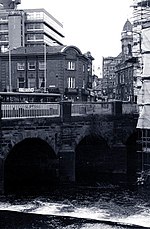Wicker Arches
Bridges completed in 1848Bridges in SheffieldBridges over the River Don, South YorkshireGrade II* listed buildings in SheffieldGrade II* listed railway bridges and viaducts ... and 5 more
Matthew Ellison Hadfield buildingsRail transport in SheffieldRailway viaducts in South YorkshireStructures on the Heritage at Risk registerUse British English from March 2018

Wicker Arches form a 660-yard (600 m) long railway viaduct across the Don Valley in the City of Sheffield, England. They take their name from the thoroughfare Wicker, which passes through the main arch of the viaduct and was, until the completion of the Sheffield Parkway, the main route eastwards from the city to the M1. It is a Grade II* listed structure.
Excerpt from the Wikipedia article Wicker Arches (License: CC BY-SA 3.0, Authors, Images).Wicker Arches
Wicker, Sheffield Burngreave
Geographical coordinates (GPS) Address Nearby Places Show on map
Geographical coordinates (GPS)
| Latitude | Longitude |
|---|---|
| N 53.3883 ° | E -1.461 ° |
Address
Wicker
Wicker
S3 8GL Sheffield, Burngreave
England, United Kingdom
Open on Google Maps









